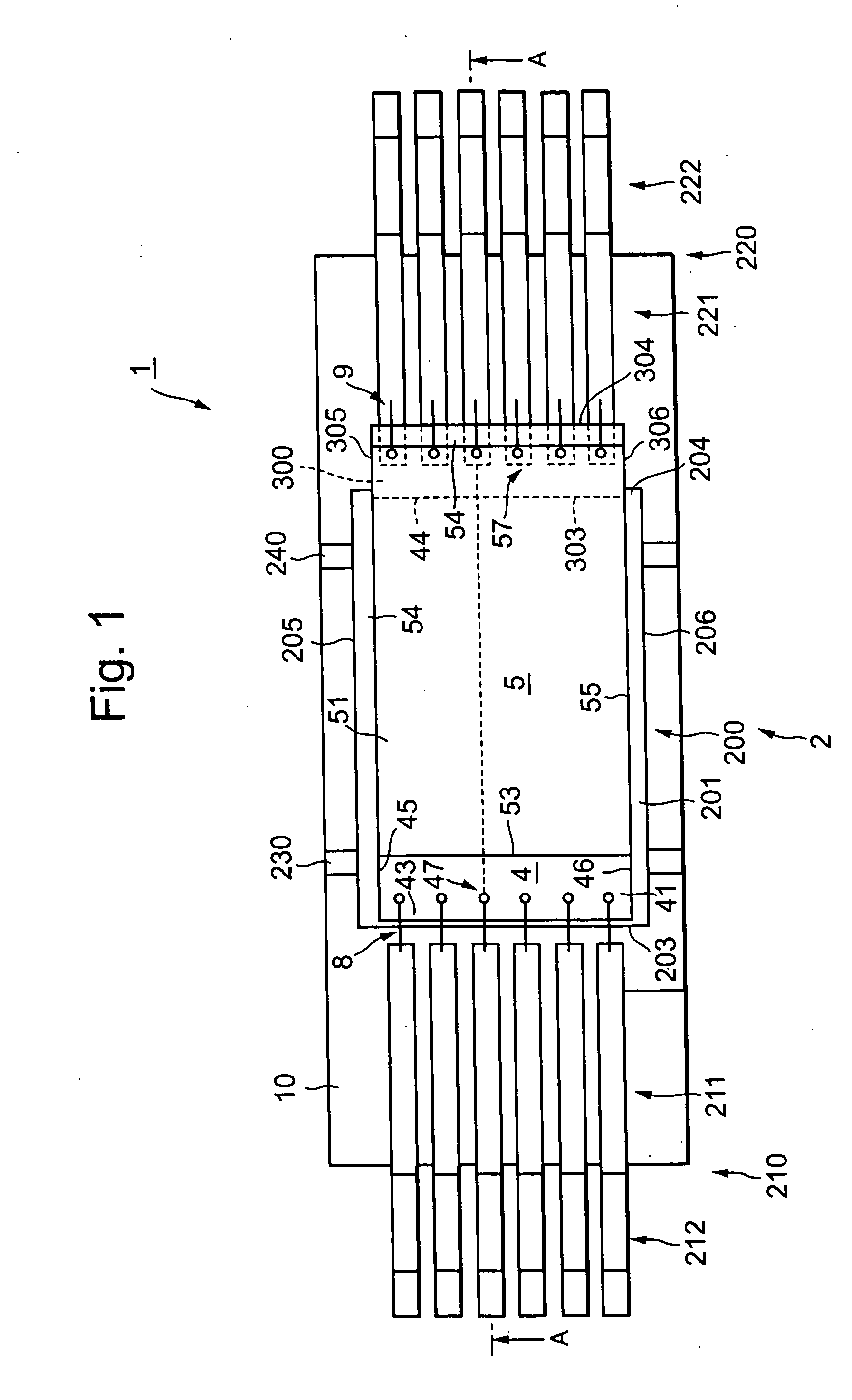Semiconductor device and manufacturing method thereof
a semiconductor and semiconductor technology, applied in the field of semiconductor devices, can solve the problems of deteriorating connection state between the electrodes of the protruding portion and their corresponding metal wires, inability to satisfactorily transfer ultrasonic sound to the metal wires and electrodes, and cracks in the upper semiconductor chips, so as to prevent the occurrence of cracks and ensure the connection
- Summary
- Abstract
- Description
- Claims
- Application Information
AI Technical Summary
Benefits of technology
Problems solved by technology
Method used
Image
Examples
first embodiment
[0032]FIG. 1 is a top perspective diagram (corresponding to a diagram from which an upper resin encapsulating body is omitted) of a semiconductor device 1 according to a first embodiment of the present invention, and FIG. 2 is a cross-sectional view taken along line A-A of FIG. 1, respectively. The semiconductor device 1 is a semiconductor memory device, for example.
[0033] The semiconductor device 1 comprises a lead frame 2 having a die pad section 200 and lead terminal sections 21b and 220, semiconductor chips 4 and 5, a support member 300 and wiring sections 8 and 9 made up of a plurality of metal wires.
[0034] The lead frame 2 includes the die pad section 200, the lead terminal sections 210 and 220 disposed on both sides of the die pad section 200 with a predetermined interval (0.5 mm, for example) defined therebetween, and support portions 230 and 240 for supporting the die pad section 200. The die pad section 200 is shaped in the form of a substantially rectangle as seen in th...
second embodiment
[0054]FIG. 8 is a cross-sectional view of a semiconductor device 1 according to a second embodiment of the present invention. In FIG. 8, components similar to those employed in the first embodiment are respectively identified by the same reference numerals, and the description thereof will therefore be omitted. A plan view of the semiconductor device 1 according to the second embodiment is similar to FIG. 1 according to the first embodiment. The present embodiment is different from the first embodiment in that a semiconductor chip 4 and a support member 300 are integrally formed.
[0055] The semiconductor chip 4 and the support member 300 according to the present embodiment are formed on such a semiconductor wafer W as shown in FIG. 9(a). The semiconductor chip 4 and the support member 300 are formed by being partitioned by scribe lines xi (where i=1, . . . n . . . ) and yj (where j=1, . . . n . . . ) for separating the semiconductor wafer W into respective chips as shown in the same...
third embodiment
[0066]FIGS. 12 and 13 are respectively a plan view and a sectional view of a semiconductor device 1 according to a third embodiment of the present invention. Components similar to those employed in the first embodiment are respectively identified by the same reference numerals, and the description thereof will therefore be omitted.
[0067] In the present embodiment, a lead terminal section 220 has a bent portion 220a on the die pad section 200 side. The bent portion 220a functions as a support member. The bent portion 220a is bent in the direction of the semiconductor chip 5 on the die pad section 200 side of the lead terminal section 220 and extends along a surface 52 of a semiconductor chip 5 at the same vertical position as a surface 41 of a semiconductor chip 4. The semiconductor chip 5 is bonded onto the surface 41 of the semiconductor chip 4 and the bent portion 220a by an adhesive sheet 7.
[0068] Upon wire bonding, a lead frame 2 is placed on a heat coma 400a having a portion ...
PUM
 Login to View More
Login to View More Abstract
Description
Claims
Application Information
 Login to View More
Login to View More - R&D
- Intellectual Property
- Life Sciences
- Materials
- Tech Scout
- Unparalleled Data Quality
- Higher Quality Content
- 60% Fewer Hallucinations
Browse by: Latest US Patents, China's latest patents, Technical Efficacy Thesaurus, Application Domain, Technology Topic, Popular Technical Reports.
© 2025 PatSnap. All rights reserved.Legal|Privacy policy|Modern Slavery Act Transparency Statement|Sitemap|About US| Contact US: help@patsnap.com



